i know the effects of soldering photo-resistor to HC-SR501 PIR module. It then detects movement in the dark only. But can anyone tell me that what is the effect of adding a thermistor to the same PIR module? There is a provision in module itself to solder both photoresistor and thermistor. I searched on the internet but in vain. I m sure someone here can help me out. Thanks in advance.
-
I plan to use this outdoors in Canada, where temps may go to -30C or lower in the winter. The sensor is rated -15 to 70 (presumably Fahrenheit). Guess it won't work as intended! – Tom Nov 24 '20 at 23:06
-
It may work under -15C - but its not guaranteed to. – Russell McMahon Nov 25 '20 at 03:50
2 Answers
I don't know how you searched on the internet, but the very first document popping up in Google has this:
Temperature compensation (optional, factory reset): In the summer when the ambient temperature rises to 30 ° C to 32 ° C, the detection distance is slightly shorter, temperature compensation can be used for performance compensation.
The second document has this:
The HC-SR501 circuit board has solder pads for two additional components. These are usually labeled.
RT – This is meant for a thermistor or temperature-sensitive resistor. Adding this allows the HC-SR501 to be used in extreme temperatures, it also increases the accuracy of the detector to some degree.
RL – This connection is for a Light Dependent Resistor (LDR) or Photoresistor. By adding this component the HC-SR501 will only operate in darkness, a common application for motion-sensitive lighting systems.
- 11,755
- 2
- 20
- 56
-
Thank you for your swift reply... Lesson learned- ALWAYS THOROUGHLY CHECK THE DATASHEET. – Milind Aug 06 '18 at 13:59
Temperature compensation (optional, factory reset): In the summer when the ambient temperature rises to 30 ° C to 32 ° C, the detection distance is slightly shorter, temperature compensation can be used for performance compensation.
This schematic shows RT1=1M ( rated at 25'C)
In order to increase the sensitivity of the sensor with a rise in ambient temp. an NTC thermistor is used to increase the range with higher ambient. Although there are a variety of Beta gain factors for NTC's no other information seems to be given.
Here the sensitivity is limited by R13=10k and this board has an opearting range from Temperature: – 15 ~ +70
So I would expect the RT1 to drop from 1M @ 25'C towards 10k @ 70'C
REF SCHEMA

- 1
- 3
- 54
- 182
-
1Thanks for your comment. So what I now gather from your comment is that - PIR range(or sensivity) decrease as temperature rises. - Adding NTC thermistor will counter any sensitivity loss due to temperature rise. I have one doubt though. It appears that PIR sensor are prone to false detection when temperature rises. Does soldering thermistor can reduce this particular error? I hope that you can shed some light on this. – Milind Apr 25 '19 at 05:33
-
I see. Perhaps "detection distance is slightly shorter, " means more likely to false trigger. I have never used them. – Tony Stewart EE75 Apr 25 '19 at 11:20